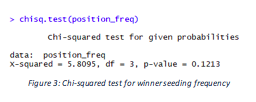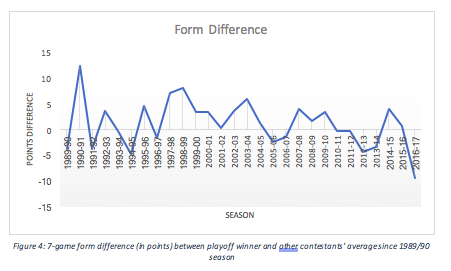Author: Enzo Profili (McCormick ’21)
In the Champions League Final weekend, the most valuable match, surprisingly, is not Liverpool versus Real Madrid: it is the English Championship Play-off Final, to be played by Fulham and Aston Villa (two of my favorite clubs, unfortunately) at Wembley.
The Championship playoffs are a mini-tournament that starts in the semifinals, in which the 6th up to the 3rd place in the Championship play and the winner is promoted to the Premier League. Promotion is worth over £200M in broadcasting, matchday and sponsorship revenues, making the Playoff final the most valuable single sporting event in the world. But what decides who wins? Do form and league position play a factor?
To answer these questions, I gathered info on the English lower divisions (2nd, 3rd and 4th tiers) since they adopted the playoff system, in the 1989/90 season. With this info, I looked who won each playoff and established the winner’s seed. The seeding is determined according to the final league table, with the highest-placed team (usually the 3rd in the league standings) receiving the 1st seed and so on. Below is a graph with the number of winners for every seed:
We see here that 1st seeds are the most frequent winners, being promoted 30 times out of the possible 84. To check if this was due purely to chance, I ran a T-test with a 2.5 (the expected average position) mean as the null hypothesis, and I found a P-value of 0.06. In this case, the lower the P-value, the higher the correlation between seeding and winning the playoffs.
This 0.06 P-value is low but not enough to say league position definitely plays a role in the playoffs at a 0.05 significance value. In the Championship alone, the P-value is 0.20, a weaker correlation. Since this frequency data does not follow a normal distribution, I also attempted a chi-squared test to make sure this P-value is correct, and it yielded pretty much the same P-value (0.12) as a two-tailed T-test, as can be seen below. Therefore, the T-test can be trusted, and seeding is likely (but not certain) to be a factor in a team’s playoff run.
For form, I followed a similar procedure. I wrote down every playoff participant’s 7-game form to end the season (only for the Championship here) and, for every season, calculated the difference between the winner’s form and the average of the other contenders’. If form plays a role in the playoffs, this number should be usually positive. In fact, on average, the winner earns 1.14 points more than the average of the other clubs.
We can see in this graph that the biggest “upset” happened last season, when Huddersfield Town won the playoffs while earning only 7 points in the last 7 games of the season, almost 10 points less than the average of the other playoff contenders.
To see how significant this figure is, I ran a T-test, since the data gathered is normalized. This test determined a 0.09 P-value. Similar to the position T-test, this test yielded a low but not definite P-value at a 0.05 significance value. This means form probably correlates to winning the playoffs, but we can’t reach a conclusion.
There certainly is a different atmosphere in the playoffs that affects football clubs, so that the best team does not necessarily win. However, we see a possible correlation between position/form and winning it all. So, clubs should enter the playoffs being the most regular and most in-form clubs around.
Email: EnzoProfili2021@u.northwestern.edu






Be the first to comment on "Do form and position make the EFL Championship Playoff winner?"